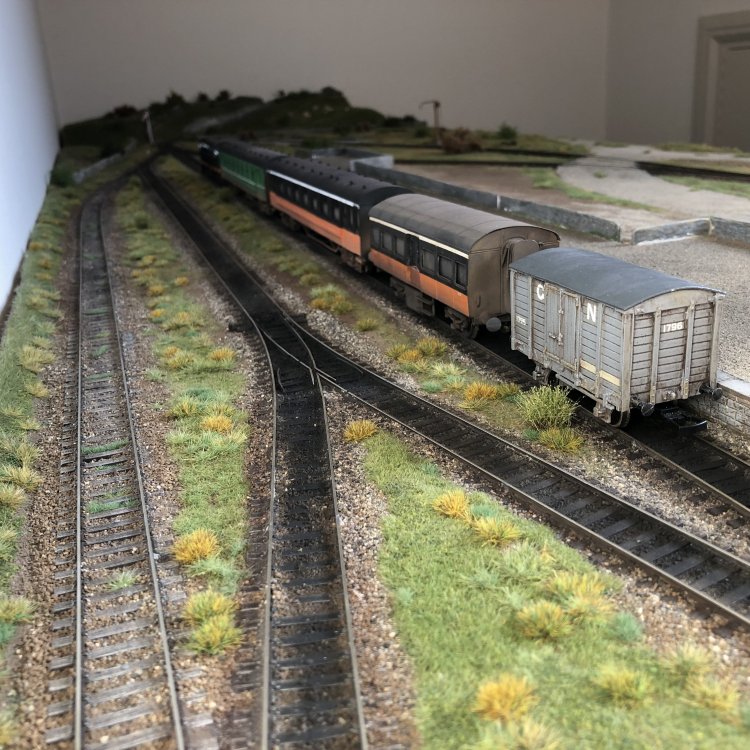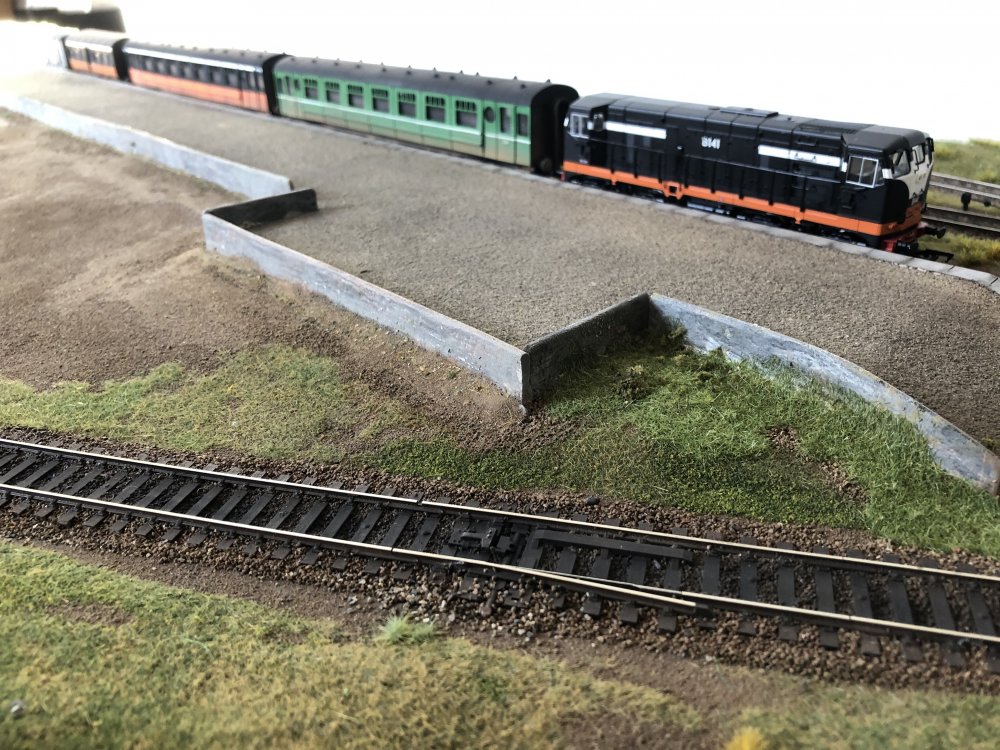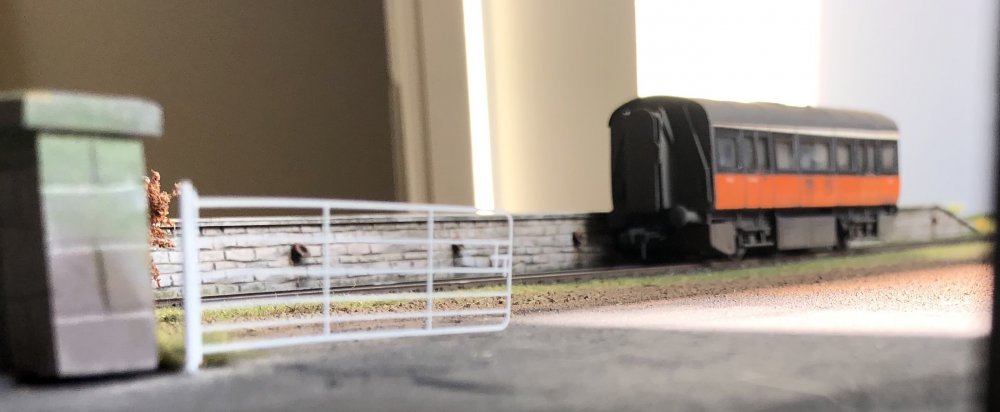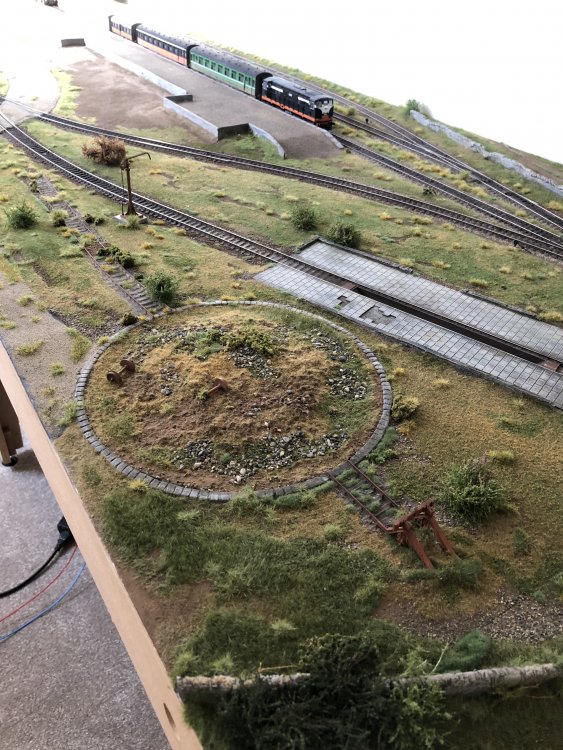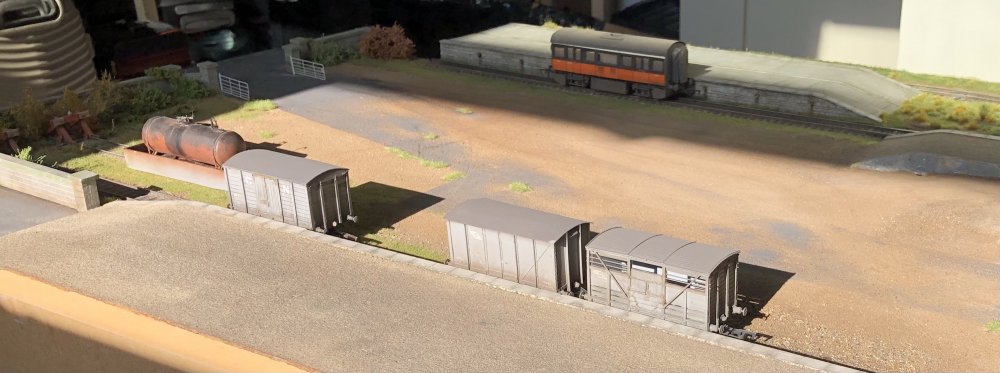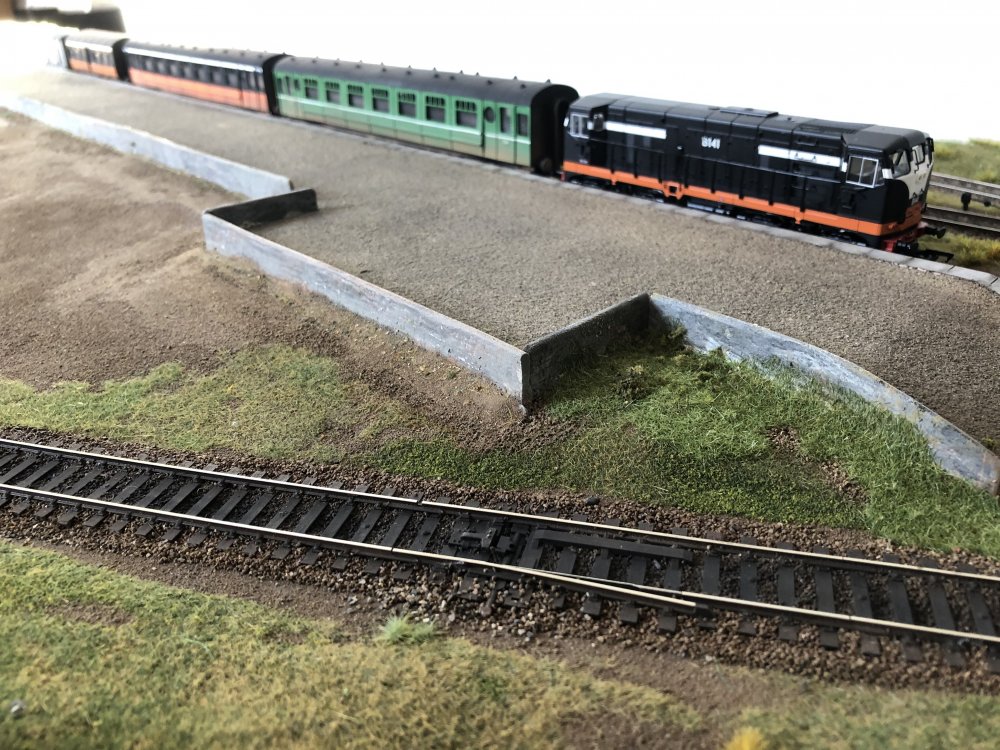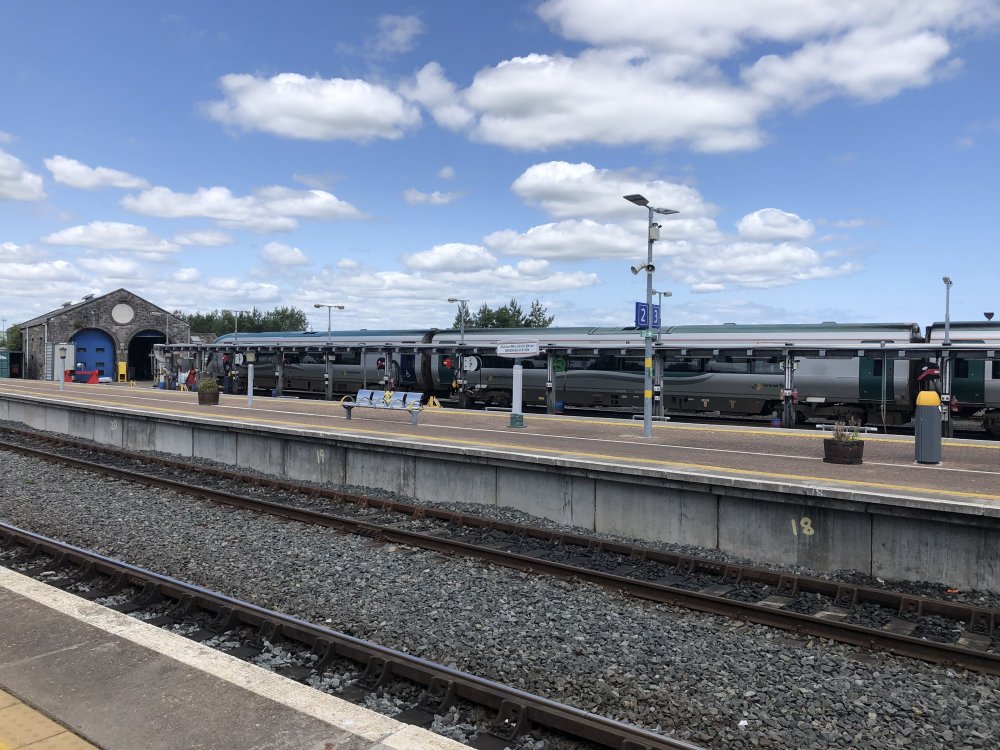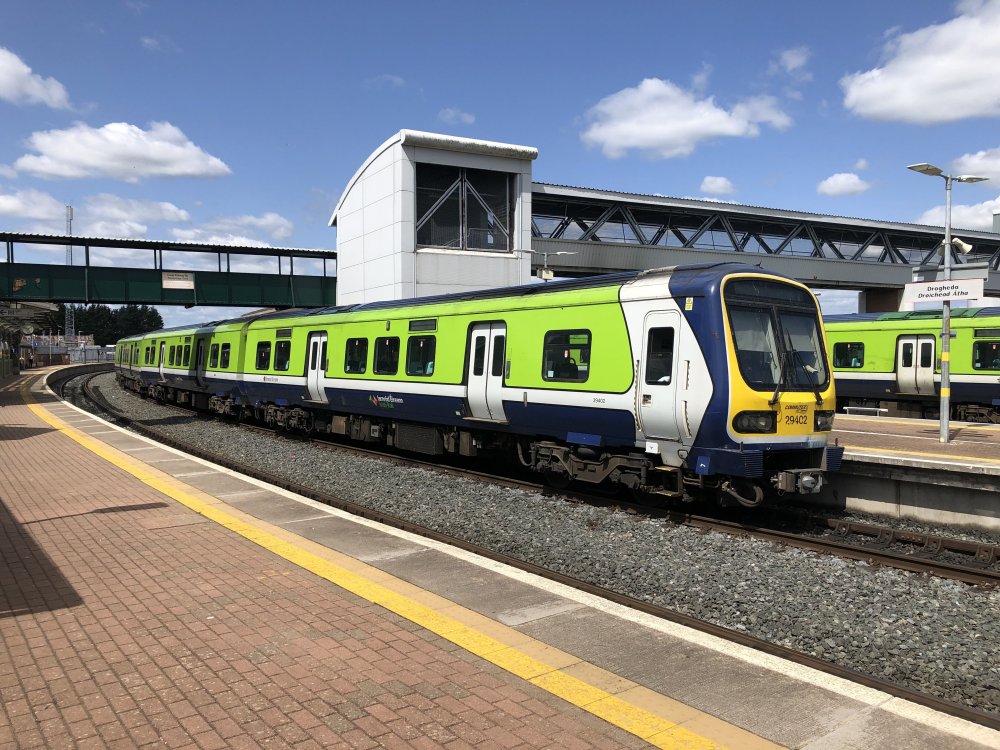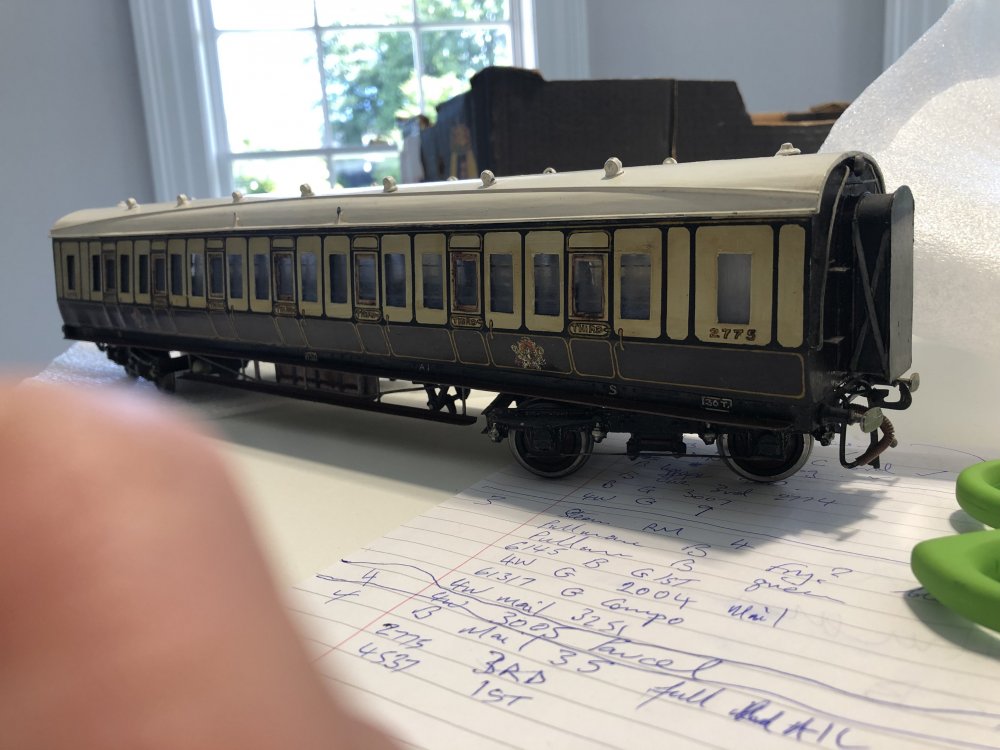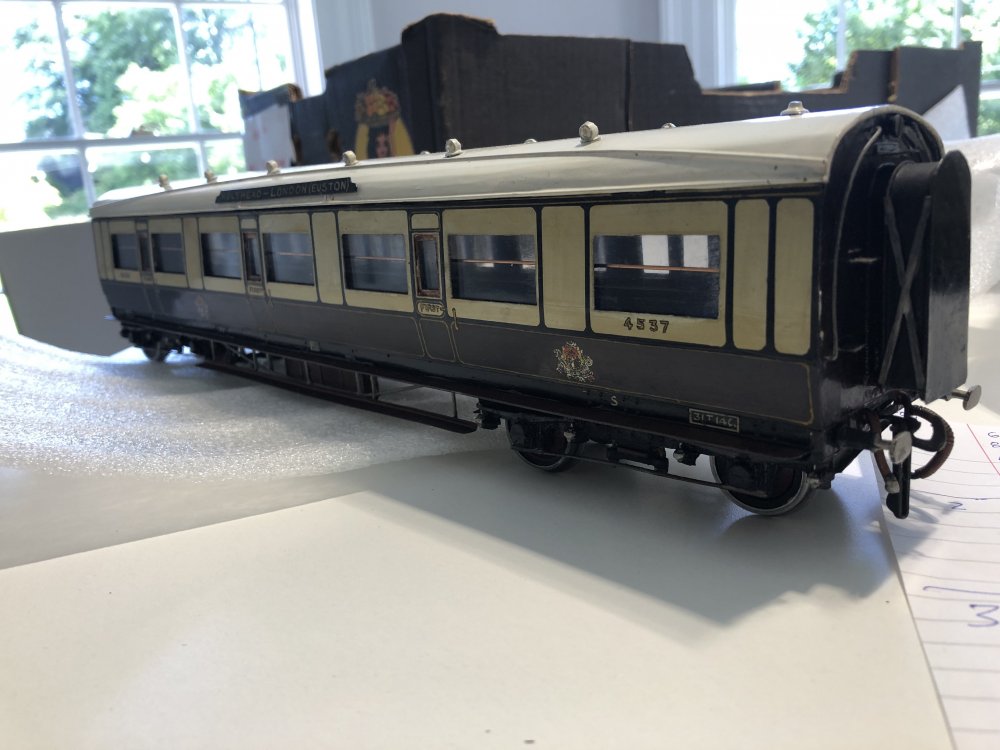-
Posts
15,862 -
Joined
-
Last visited
-
Days Won
393
Content Type
Profiles
Forums
Events
Gallery
Everything posted by jhb171achill
-
That's the whole idea, Edo - so it's worked! Phew! In my teens I got to all sorts of places like this which had seen better days, but were still operational - this seemed to add to their atmosphere. Westport Quay was one, and the trackplan here closely resembles that place. With no MGWR kits on the go when I started designing this, but nice SSM and Worsley etches of GSWR prototypes then available, I decided to move "down south"; thus, the place is somewhere in West Cork or West Kerry, which also gives the opportunity to make the sort of corrugated buildings that were popular in that area, and which (a) I like, and (b) are easy to make! The real Dugort, by the way, is a small village (or what's left of one) on the north coast of Achill Island. Many a time I will operate this section of the layout as if it's a three-times-a-week-if-required goods-only line, like Castleisland at the end. A place which hasn't seen a passenger service, GAA days apart, since 1937.....A J15, "C" or a 141 appears, shuffles a few vans about, and potters off again, observing the 20 mph speed limit as it rocks and rolls through the weeds up to the main "town", where the six coach twice a day to Cork is about to depart.
-
What appears to be a sort of "lay-by"(!) on the main platform is where the buildings will go. There will also be a small goods store and small yard crane, which I've weathered within an inch of its life.
-
After many twists and turns, and a house move, I am delighted to have had a visit from Baseboard Dave today with a vanload of great goodies. Dugort Harbour has arrived. Dave will post a pile of pics later on, but a few teasers here; it's 20th July 1964 and the 17:35 to Castletown West is about to depart - or it would, if the height of the layout matched the further extension that it is going to be connected to - but that's in hand. As originally conceived, it was to be a standalone shunting layout, based on a place like Baltimore, Valentia Harbour or Westport Quay. The idea was to have this plus a fiddle yard; trains leaving the place going along a fictitious four or five mile branch to the nearest big town. It has an air of desolation to it. This is intentional, though a West Cork / Kerry-like corrugated sheet station building will be added when I get around to it, plus a few people and cars. The prototypes mentioned above only seem to have survived as they were too insignificant to be worth listing for closure in themselves - though Westport Quay was retained in order to provide access for a fuel tanker to stabled buses - this is imitated here with an oil tanker grounded for the same purpose; a raison d'etre for such a lonely place to retain a train service at all. Like many lines that CIE want to close, the service is sparse. A daily goods will serve the place, with a morning and evening passenger train, mixed in steam days. It will only come to life when the local GAA crowd set off en masse for Croker, the beet season is in full swing, or the monthly cattle fair is due. In the fictitious setting, now that it is in a new house, there is scope for extension (hence the mismatching height of new boards installed and ready for track!). This extension will include a medium sized town station, from where the main line train from Cork or Dublin arrives twice daily, a la Lismore / Dungarvan, Clonmel or Bantry. A connection goes out to Dugort Harbour. Once the "main" station is complete, the main line trains will leave there to a fiddle yard, so the routine will be Fiddle Yard ----(main line)---- Castletown West ----(branch)---- Dugort Harbour. One thing that initial trials show up is the bad idea of various RTR and kit-built stock having slightly different couplings; derailments galore. I may well foist some 15 locos and 50 coaches and wagons some day on some poor soul with a request to put kadees on the lot. Just a few adjustments. Buildings have to be added (I have a goods shed started). Slight adjustment to a platform edge, as it and a JM Design "tin van" have fallen out over clearance issues, but that's easily fixed. Backscenes are desperately needed; that will be a priority. The "main" station will have a turntable, allowing locos to turn before going back to "Cork", a fictitious two or so hours away. But on the branch, the old turntable pit is filled in and the shed demolished; it IS the "swinging sixties" after all, so tender first running there. So, back to a summer evening back in 1964. Bet you didn't know they had drones back then.......... From the goods yard gate, stock lying about. And from a very youthful ”TTCs” or “Wanderer’s” drone….
-
Absolutely stunning!!!!
-
You were spot on the first time, Midland Man, well done; I was just curious - then I saw Errigal behind, so it couldn't be anywhere else! I've recently got a load of Senior's old prints scanned to a better quality than the ones I posted a year or so ago. He only travelled to Burtonport once, and took very few pictures; this was taken from the footplate of No. 12, one of the 4.8.0 tender engines, near Gweedore. Now, for Lough Swilly experts, WHAT is that ballast siding on the left? WHERE exactly was it? 100% right!
-
What makes you think that, may I ask?
-
Going back to the theme of this thread, any guesses where this might be? (H C A Beaumont collection)
-
....calling at Skibbereen, Paris (Orly), Strabane, Achill and Harmonstown...... Yes, they are both from Inny Jct. They would have been on different platforms. The main line down side would have said "To Cavan, Clones Junct. & Killeshandra" and the other "To Longford, Ballaghaderreen & Sligo", exactly as you say. Kilfree would have simply said "Change for Ballaghaderreen" or just "To BGallaghaderreen" or something like that. I pinged the auctioneer and told him that he ought to make clear in his advertising that these are not the same sign.
-
Yes, there was a GN loco shed at Cavan, and MGWR / GSR locos only went that far from Inny Junction (or, more specifically, Mullingar). Even between September 1957 and April 1959, when Inny Jct. - Cavan - Clones - Dundalk was basically one single long goods-only route, ex-GN steam locos still operated from Dundalk to Clones, and "C" class diesels operated from North Wall - Inny Junction - Cavan. There was no operational reason why it couldn't have been done as one route - maybe it would have at least lasted until the 1967 closures on that basis. Layout idea: Cavan in 1966 - goods only, but many a GAA special! There WERE a very small number of diesel operations from the Midland line north of Inny Jct. An "A" class took a GAA special out of Monaghan one time, south to Cavan and on via Inny Junction to Croker. But regular services never crossed over. ....calling at Skibbereen, Paris (Orly), Strabane, Achill and Harmonstown......
-
That's exactly what it is - two separate signs. Pity! Useless in that combination....
-
That is an absolute work of art! Prior to about 1900-05, they would have been a very dark olive green, as authentically seen on two of Fry's models plus No. 90 at Downpatrick. After 1915, the all-over grey. So here, we're in 1900-15!
-
Nach labhraíonn tú Gaeilge ar bith?
-
Photographic Website Updates
jhb171achill replied to thewanderer's topic in Photos & Videos of the Prototype
NOW you’re talking! Imagine “Woolwich” music up that tunnel! -
Photographic Website Updates
jhb171achill replied to thewanderer's topic in Photos & Videos of the Prototype
The scenic and aesthetic beauty of Irish railways personified: A long scaffolding with pipes and bits on it poses gracefully in front of a silver customer-tube on wheels. -
Good thoughts, Paul - Fingal CoCo need to deal with external stuff. Valid point which I will pass on. I’ve mentioned DCDR & RPSI stuff to them before - worth following up again.
-
Photographic Website Updates
jhb171achill replied to thewanderer's topic in Photos & Videos of the Prototype
-
When dealing with models which are very old, the utmost care has to be taken in handling them. Years in an inappropriate storage environment before the Malahide thinbg got under way and proper conservators got involved, buffers had fallen off, soldering joints parted company and in this case, the old timber piece used to make this van cracked. Some types of damage are restorable, others not. Now, the entire building they are in has temperature and humidity controlled all the time. Nothing will not deteriorate in SOME way over time, but the slower this process can be made to be, the better. Fry's modelling went through three stages - like many of us. He started off as a child with bought Hornby stuff; there was no IRM Towers then, and Paddy Murphy's parents were probably learning their spellings! So, he started off by buying "bought" stuff, then graduated to repainting or altering "bought" stuff. Then scratch built with a lot of wooden blocks, finally much higher quality tinplate modelling and his own castings. His earliest models date from the mid-1930s, and finishes are not always as good as later. In particular, he appears to have made leaps and bounds after about 1941, when he truly mastered tinplate. Earlier models used wooden underframes and the details were much cruder. Have a look at the two chassis below. One is of this "cracked" bogie goods van which he built in the early 1930s, and look what less than a decade makes as a difference; formed tinplate chassis now, with a lot more detail, on the underside of the four wheeled LNWR coach shown. The bogie LNER van is the one with the crack going the whole way down the body. Close examination suggests that crack has been there a long time.
-
Photographic Website Updates
jhb171achill replied to thewanderer's topic in Photos & Videos of the Prototype
Janey mac..... Limerick to Ballybrophy in a 7-Up can, in under a day......... -
He sold me six for an even £10,000 and included even the sausages in his logo......
-
-
A pair of mainline LNWR corridor coaches. The vast majority of Fry’s British passenger stock is of LNWR origin, as he travelled over their lines while attending boarding school in England.
- 295 replies
-
- 10
-

-
Today's update on all things Malahide Model Railway Museum. Following Drew's suggestion above, signage will be ordered to explain the four scenes on the layout. There's an overall review of signage going on anyway, so it's now included in that. When the place was opened, the initial thought was that roughly half of all of Fry's models could be displayed, and the other half stored; the two sets being swopped several times a year. I advised against this at the time, for the obvious reasons of constant handling not being in the best interests of the models, to put it very mildly. So, I thought, I will select the more interesting half, and get them to put up pictures of the rest. Result. However, once the display cases were installed, it became evident that a very much greater proportion of his models could be displayed. The models Fry built (as opposed to the ones built later by other folks for the Castle layout) consist of approximately two thirds Irish, almost a third British prototypes, and a dozen or so mainland European items, plus an American five-car diesel train which Fry repainted. So, with more space than expected, the entire Irish collection (bar several duplicates) has been displayed. The only Irish stuff not displayed are one badly broken open wagon (similar to others anyway), a couple of half-built things (possible focus of a future "work in progress" display) and several duplicates - e.g. he made several "H" vans, and more than one of certain designs of BCDR, CIE, GNR and NCC coaches. In the latter case, one of each is on display and the others are stored. There was just about enough room for all but (I think) one of the mainland European stuff. This left the British stuff, which is a mix of the following: (a) LNWR coaches and locos - probably half or more of the British stuff; (b) other one-offs (like a BR 1950s sleeping car), and (c) well-used bought Hornby stuff which Fry had as a kid. There is no room for all of this anywhere. Today, we had a look round the place to evaluate proposals for more glass cases, with a view to displaying this material (not the Hornby models). If this can be achieved, ALL the Fry-made stuff, bar a few items retained by members of the family, and which were never gifted away at all, will be on display. There had been various ideas about where we might display this stuff. The most likely option has been changed, so these days I'm packing this stuff into proper conservation boxes as they're likely to be out of sight for a few years. I'll post a few pics here in the coming days and week. To start with, this is a working LNWR mail coach. The trigger underneath activated the net mechanism on the side, to make the net drop to pick up mail bags. You can see the spring attached to the trigger on the underside of the coach. Fry got a batch lot of LNWR crests made. Some are on the side of a GSR coach as a "GSR" crest and a couple of Dublin trams have them too! They're somewhat overscale too - a common complaint of crests and logos on model coaches of all types.
- 295 replies
-
- 11
-

-
Vallejo possible paint match CIE tan/orange colour
jhb171achill replied to Noel's topic in General Chat
Looks a BIT bright, perhaps, though not far off?
.png.c363cdf5c3fb7955cd92a55eb6dbbae0.png)

